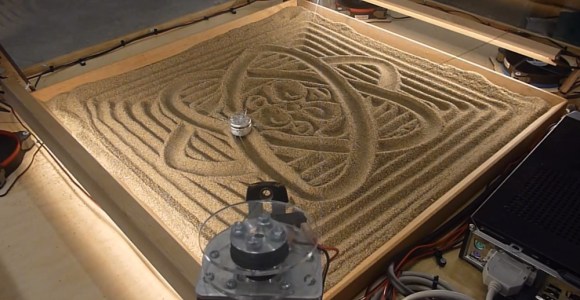[David] has created a four cable drawing machine for the Telus Spark Science Centre in Canada. Hackaday has featured [David's] unconventional drawing contraptions before, specifically his center pivot pen plotter. The drawing machine is a new take on a drawbot, and could be considered to be close cousins with [Dan's] SkyCam. The premise is simple: A stepper motor with a reel of string is placed at each corner of a square. The strings for all four motors come together at a center weight. When all four strings are taut, the weight is lifted off the drawing surface. When a bit of slack is added into the strings, gravity pulls the weight down to touch the sand.
It’s at this point that a simple premise becomes a complex implementation. Moving the weight in one direction is a matter of reeling out string on one motor, and reeling in string on the other. But what about the two “un driven” strings? They have to be slack enough to allow movement in the driven direction, but not so slack that the weight can dig in and tumble on the sand, causing a tangle. To handle some of these questions, [David] called on [Kevin] to write some software. [Kevin] created a custom kinematics module for LinuxCNC to control the drawing machine. The drawing machine runs on Gerber Code, similar to a CNC. Simply feed the machine Cartesian coordinates, and [Kevin's] module converts to steps.
The hardest part of the building the machine was creating a homing system. Be it a CNC, 3D printer, or a four cable drawing machine, any stepper motor based system has to have a home position. Stepper motors are open loop systems. They are very precise to move, but there is no way to tell where they are at any given moment in time. The most often used method is to get to a known “home” position and use software to keep track of steps. [David's] problem was getting to the home position in the first place. If he doesn’t know where the weight is, he can’t reel out too much string or he’ll wind up with a tangled mess. His solution was actually pretty simple. He commands one motor to reel in and tells the others not to move. The moving motor is stronger than the holding torque of the other motors, which allows it to pull the weight up until it hits a switch on the pulling motor’s mount. This type of “tug of war” makes all sorts of noise, and requires a stoutly built machine. The results speak for themselves though – [David's] machine looks great!
Filed under: cnc hacks

+ Reply to Thread
Results 1 to 1 of 1
-
12-08-2013, 05:34 PM #1
Four Cable Drawing Machine Pulls Our Strings
Thread Information
Users Browsing this Thread
There are currently 1 users browsing this thread. (0 members and 1 guests)





 Reply
Reply
Bookmarks